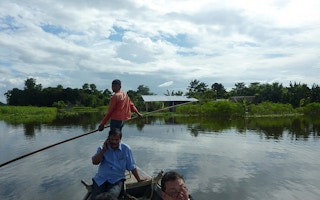By the end of July, an estimated 300 people have been killed by floods, around three million have been forced to flee their homes, over 100,000 animals have been drowned – including 21 rare and endangered one-horned rhinoceros – as a water-parched South Asia has suddenly got too much of it since the start of the monsoon in mid-June.
As the Ganga, Brahmaputra, Indus and their tributaries swelled with rain water large swathes of farmland were inundated in Bangladesh, Bhutan, India, Nepal and Pakistan. Parts of large cities such as Dhaka, Guwahati, Patna, Allahabad, Lahore, Sialkot and Gujranwala went under water, and the same fate threatened New Delhi.
It is not as if it has been an especially vigorous monsoon. In fact, the India Meteorological Department says the rainfall during June and July has been exactly the same as the long-period average. It has even been 13 per cent deficient in east and northeast India.
Southern Bhutan flooded
Relative to its size, Bhutan is perhaps the worst flood-hit country in South Asia right now. King Jigme Khesar Namgyel Wangchuk has joined ministers and officials in the rescue and relief efforts in the southern parts of the country.On July 21, the town of Sarpang Bazar was entirely washed away by floodwaters, which also cut off the road to the town of Gelephu.
Choden Drukpa, a 40-year-old resident of Sarpang Bazar who earns her living by renting out farmland and shops, said her life had been shattered. She was one of 52 families left homeless when the Sarpang River broke its banks, following continuous heavy rainfall. “We managed to take out some belongings but lost the source of our livelihood, the land,” said Drukpa.
With floodwaters and landslides cutting off the highway from Phuentsholing on the India border, landlocked Bhutan is already experiencing shortages of food and fuel. Power transmission lines have been brought down by landslides and many parts of the country are without electricity. The highway was reopened after five days, and the shortages are expected to ease soon.
Prime Minister Tshering Tobgay went public with a declaration that there was enough food in every district warehouse and asked people not to panic.
The department of roads has reported that nine gewogs (districts) were totally cut off when the Buduney Bailey bridge in Samtse district collapsed on July 21. Many other roads, especially to remote districts in the eastern parts of the country, were blocked by landslides.
“
We managed to take out some belongings but lost the source of our livelihood, the land.
Choden Drukpa, resident, Sarpang Bazar
Floods affected the construction site of the second hydropower project on the Punatsangchu River, with its water diversion tunnel and coffer (temporary) dam under water. Ironically, this was a year when Bhutan had faced a rare drought before the onset of the monsoon, and many farmers had been forced to leave their lands fallow. The Bhutan government is now laying emphasis on developing flood early warning systems along its rivers.
Assam, Bihar worst hit in India
As Bhutan struggles to bring things under control, India’s northeastern state of Assam is struggling. In terms of size of area affected, it is the worst hit. In the Brahmaputra basin 34 people have died and another 1.1 million have been displaced, according to official records. Kaziranga, the world famous rhinoceros sanctuary on the bank of the Brahmaputra, is flooded – some of the rhinos have been drowned, others run over as they tried to cross a busy road to higher ground.
Such widespread flooding during a normal monsoon season is in line with the prediction of scientists – climate change is leading to fewer rainy days, but more intense rainfall on those days. In this situation, the rainwater has less chance of percolating underground and recharging the water table. It rushes along the surface instead.
Riverbeds silted due to ill-planned embankments, dams and barrages do not help.It is the same story elsewhere in India, where 118 people have been drowned by floodwaters according to official records, mostly in the Ganga basin states of Uttarakhand, Uttar Pradesh, Bihar and West Bengal. The situation is particularly dire in northern Bihar, where the Gandak River has flooded many villages and forced residents to take shelter on railway lines that are built on embankments.
In many cases, people were flooded out when officials were forced to open the gates of dams or barrages to protect the structures. That is why the Yamuna is flowing above the danger mark in India’s capital New Delhi.
In Himachal Pradesh, the Sutlej – which joins the Indus downstream in Pakistan – has inundated villages through multiple flash floods in the mountain areas. The rains have been followed by landslides throughout the Himalayas. Hundreds of tourists are stuck behind them in the resort town Manali.
This story was published with permission from The Third Pole.
Read the full story here.










